Maddening months at work, trying to migrate a very large Web site to a different technology, and no end in sight. It's time to take a break and, as luck would have it, Kristin's coming for a visit. We'll go to France for a while.
You
may not find this terribly rewarding unless you're included here, so this is a
good time for casual and random browsers to turn back before they get too caught
up in the sweep and majesty of the proceedings and can't let go.

We're out for a pleasant drive in the countryside from St Céré, June 2009, through the Parc Naturel Régional des Causses du Quercy, and what's this, just across the causse?

Perched on the mountainside, it's the Architectural Spiderman, Rocamadour, or the 'Cliff of Amadour', sort of named after the saintly hermit who founded the place in Neolithic times. There's the holy level in the middle, churches etc. halfway up the cliff, and the medieval village below it, with, at the top of it all, a medieval château built to protect what was by then a very lucrative pilgrimage business.

The saintly hermit Amator or Amadour came here with his "Black Madonna" wooden statue, which he really loved a lot, which is why everybody called him Amator, the lover, even though he was a hermit and lived in a cave he'd hollowed out of the rock. But he wasn't really Amator -- in fact! his real name was Zacchaeus. What an exciting life he had (before he became a hermit) -- if you believe sacred legends, as I do, he was a marvel. At mid-life he was the chief tax collector of Jericho when Jesus came by, and being extremely short he climbed up a tree to see the passing celebrities. Jesus, who had a knack for these things, called him down by name and invited himself to Zacchaeus' house for dinner, so Zacchaeus decided to give away half his fortune, which Jesus applauded as an excellent gesture (Luke 19, you can read it for yourself).
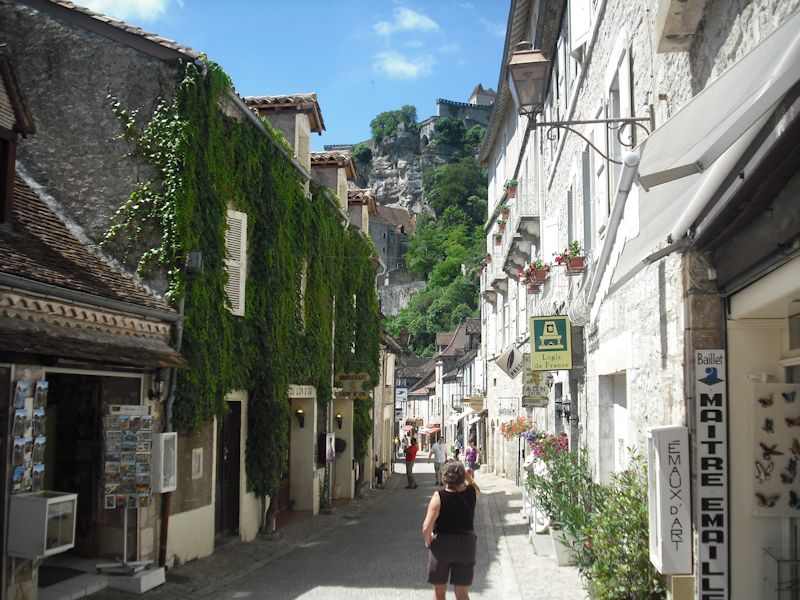
The single street through the old village (presently inhabited by 600 worthy souls), where one million tourists jostle their way down the lane per year (the second most-visited non-Disney tourist site in France, after Mont St-Michel) -- but obviously we've caught it on a good day.
Zacchaeus's (Amadour's) wife, BTW, was none other than St Veronica, who wiped that same Jesus' brow with a handkerchief as he toiled his way up Calvary Hill for his rendezvous with destiny. Small world! The pious couple was persecuted in Palestine, so they took a skiff and rowed to safety in western France. Thence they journeyed on to Rome, where they (or he) got to witness the martyrdoms of St Peter and St Paul, which were going on at about that time, and -- following that, and after his wife's death -- Zacch came on to this remote spot on the Alzou, a tributary of the Dordogne in the modern departement of Lot, the former province of Quercy, and dug out a cave for himself and his wooden Madonna, which he really loved.
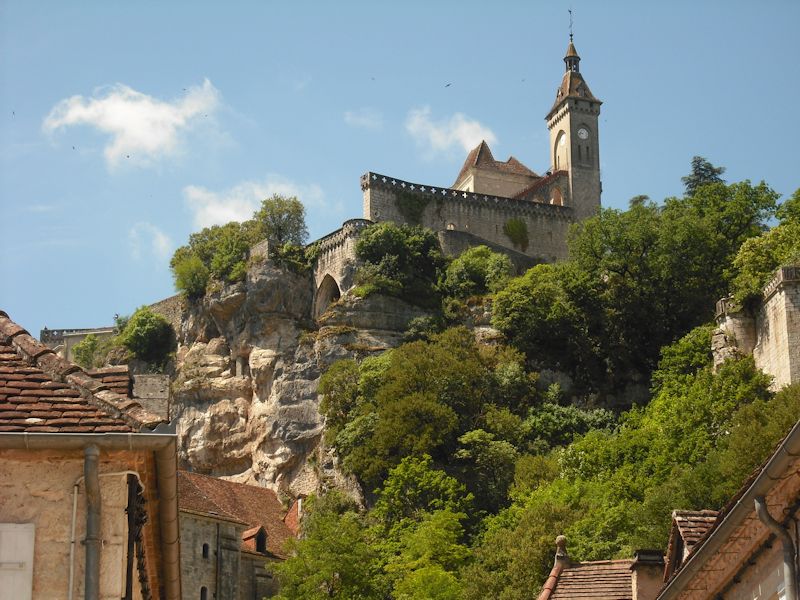
From the village, round the side from the churches' level, we're gazing up at the fortress at the top, said to be about 120 metres up but clearly way more than that!
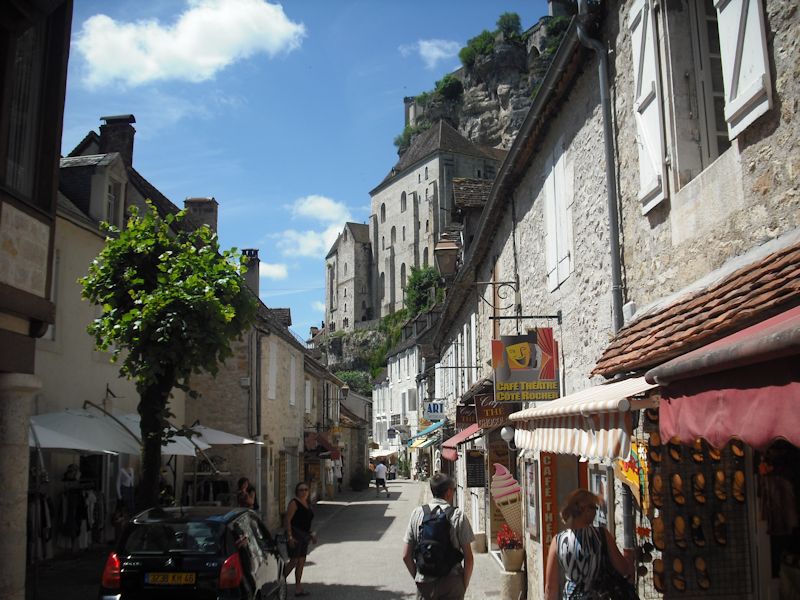
A daunting look up at the holy level, the "Plateau of St Michel", from the medieval boutiques.

Minus its million visitors a year, it really is a lovely village, with four fortified gates like this one to let the pilgrims in and keep the brigands out and hang onto the well-earned pilgrim proceeds of this ancient form of mass tourism. All to see the Black Madonna and crawl up the 200+ steps on their knees, for some reason. Probably to shorten their time in Purgatory.

Boutiques

We're not very boutiquey people, though, and it's not lunchtime, so after a few courses up and down the main street, we're looking for something else to do for a while.
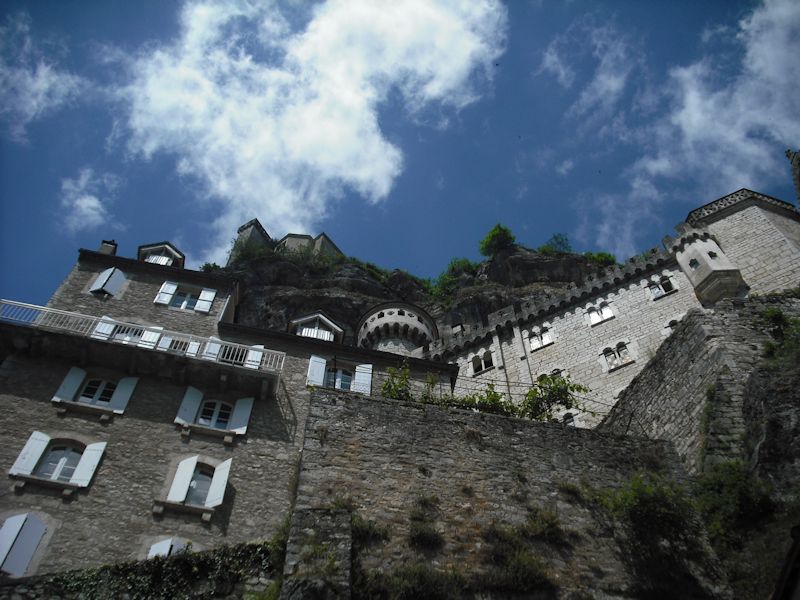
Fully aware, of course, that always looming way up there is the main reason the pilgrims showed up here year after year, after the year 1166 anyway, when a well-preserved body was dug up hereabouts, identified instantly as that of the Biblical Zacchaeus (or Amadour), and voilà, newly one of the major pilgrimage call-in spots on the long road to Santiago de Compostela. Providentially, a miracles-book dated soon after the lucky corpse was found, called the 'Miracles of Our Lady of Rocamadour', attested to the healing powers of the Black Madonna and put the place on every rich leper's agenda.

There's a convenient ascenseur up to the churches' level, but in a revered place where formerly countless good people, including kings, bishops, and worthy knights, and probably lots of very sick people as well, toiled up the cliffs on their knees, thus demonstrating something that was probably very important at the time (and shortening their time in Purgatory), it seems somehow modern and decadent to take the elevator. So we're in for it now.
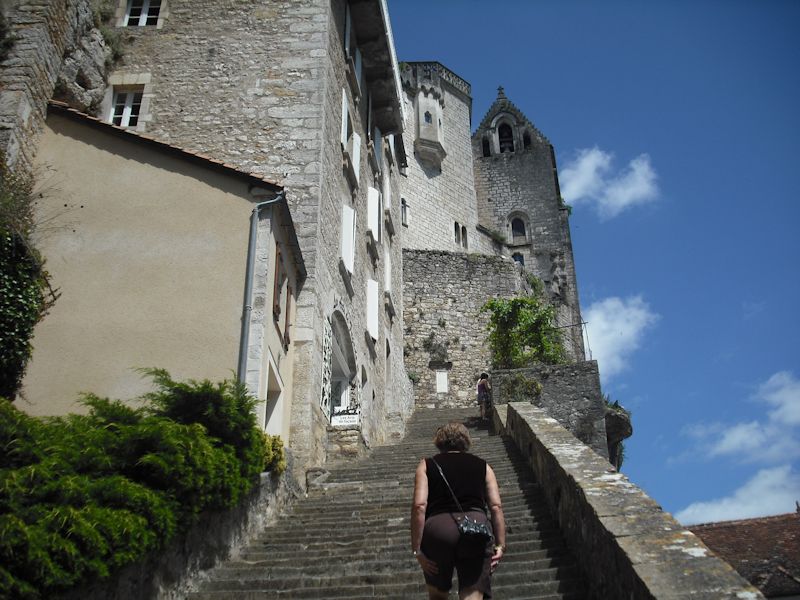
But forget about that business with the knees! The guidebooks all repeat the same error, that the "Grand Escalier" has somewhat more than 200 steps up to the churches, but clearly that's a typographical error and a zero has been dropped.
Just think - we've been preceded here, on their knees (probably with helpers, or even proxies) by Eleanor of Aquitaine, Henry II of England, a bucketful of French kings, the explorer Cartier and the composer Poulenc, and, apparently, the medieval hero Roland (of Chanson de Roland fame) who died whilst assisting Charlemagne in his defeat by the Basques at Roncevalles in A.D. 778, but not before getting his legendary sword "Durandal" stuck in the rocks of these cliffs, and just leaving it there. Where it remains to this day.

"Childe Roland to the Interminable Stairway came." This really is a long way up the hill, knees or no knees.
They say that, even today, more than two hundred years after the Enlightenment, devout pilgrims sometimes still struggle up this thing on their knees, but thank god we didn't see any of those today. After living in Oklahoma for some years, one really has no stomach anymore for that sort of thing.

Once onto the ramparts, we're taking a breathless break from the endless stairs and admiring the breathtaking views as well (which sounds self-defeating).

Rocamadour village seen down the chimneys. Where the medieval villagers raked in a fortune off people determined to struggle up the Grand Escalier on their knees and knock off some of their Purgatory time, whatever the cost to their patellae. "Men's beliefs have their cycle, their season, their birth, their death . . . as cabbages do" (Montaigne, Raymond Sebond).

The churches round the holy St Michel plateau, or Cité religieuse, radiating solid stoney holiness everywhere

The Notre Dame church on the Plateau St Michel level, beckoning with still more holiness. (In fact, we have the Chapel of Notre Dame, the basilica of Saint-Sauveur, the chapel of Saint-Michel, and the Palais des Eveques, or Bishops' Palace, all in proximity here, and I don't have any idea which is which.)

Hoopla-Ho! There's the Black Madonna. Endorphins are gushing now, what a saintly feeling -- this sort of profound religious experience is enough to make you want to dash back down the 2,000 steps and come up again on your knees. That's what the composer Francis Poulenc did in 1936, when the sight of the Black Madonna sent him reeling.

St Amadour's down in there -- I'm going to spare you the sight of the old guy himself, it's disgusting. Anyway, the Huguenots attacked this place during the Religious Wars and hacked the original saint to pieces, so what we've got here is a fairly grisly 19th century "reconstruction".

This is becoming a little too intense and unnerving. We'd better move on. Farther up.

-- Farther up!?!

The kneeworthy stairways ended at the church level, midway up the cliffs, and now we're on a winding path the rest of the way. Enlivened by shrines to the Stations of the Cross at every switchback. They probably did this part on their knees, too. This is called the Chemin de Croix, and after a while it's a bit like lugging your own cross up here on a hot day.

We're up on the château walls now (2 euros through the turnstile) and finally getting some breeze.

Kristin out on one of the inexplicable wing-walls, which must only be here to protect the gardens from intruders (medieval intruders, presumably; after the invention of cannonballs these things would have been as protective as a tent.). We're looking out across the causses and down into the ravine of the Alzou.

Nearby hillsides.

Well-sculpted hillsides, and the village below.

Farther up.

We've paid out our 2 euros each, and we're not going to miss anything.

We're sneaking now round the back of the main building of the château, towards the other wing-wall. Nobody's getting in to see the château itself, of course, not with one million tourists filing past here every year, the strain on the family's hospitality would be formidable. On the other hand, that would be a lot of euros.

The first wing-wall and the gardens, and the causse ridgeline in the distance.

Château and wall, with a tourist on it, one of more than a million expected. This is only June; they'll be along any day now.

Kristin descending towards the valley of the Alzou.

Kristin at the Gates.

More stations of the cross, etc.

And back down into the village by the less publicly sanctified route, probably just as hard on the knees, though, and then back down to the carpark.

And the saintly express train up the hill. Now, back to St Céré for dinner on the terrasse and just possibly a little accrued credit towards Purgatory. What a spiritually uplifting day.
 Dwight Peck's personal website
Dwight Peck's personal website 





































